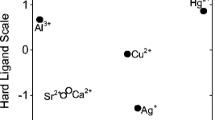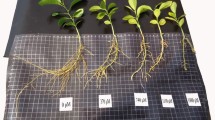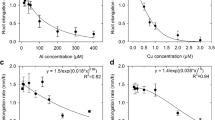Abstract
Elevated levels of many metals are toxic to plant roots, but their modes of action are not well understood. We investigated the toxicities of aluminium (Al), copper (Cu), and lanthanum (La) in solution on the growth and external morphology of 3-d-old cowpea (Vigna unguiculata L.) roots for periods of up to 48 h. Root elongation rate decreased by 50% at ca. 30 µM Al, 0.3 µM Cu, or 2.0 µM La, accompanied by a decrease in the distance from the root tip to the proximal lateral root. Kinks developed in some roots 2.0 ± 0.4 mm from the root apex on exposure to Al or La (but not Cu). Light and scanning electron microscopy showed that soluble Al, Cu, or La caused similar transverse ruptures to develop > 1 mm from the root apex through the breaking and separation of the rhizodermis and outer cortex from inner-layers. The metals differed, however, in the range in concentration at which they had this effect; developing in solutions containing 54 to‑600 µM Al, but only from 0.85 to 1.8 µM Cu or 2.0 to 5.5 µM La. These findings suggest that Al, Cu, and La bind to the walls of cells, causing increased cell wall rigidity and eventual cell rupturing of the rhizodermis and outer cortex in the elongating zone. We propose that this is a major toxic effect of Al, and that Cu and La also have additional toxic effects.







Similar content being viewed by others
Abbreviations
- ICP-OES/MS:
-
Inductively coupled plasma-optical emission spectrometry/mass spectroscopy
- SEM:
-
scanning electron microscopy
References
Blamey FPC (2001) The role of the root cell wall in aluminum toxicity. In: Ae N, Arihara J, Okada K, Srinivasan A (eds) Plant nutrient acquisition – new perspectives. Springer-Verlag, Tokyo, pp 201–227
Blamey FPC, Nishizawa NK, Yoshimura E (2004) Timing, magnitude, and location of initial soluble aluminium injuries to mungbean roots. Soil Sci Plant Nutr 50:67–76
Clarkson DT (1965) Effect of aluminium and some other trivalent metal cations on cell division in root apices of Allium cepa. Ann Bot 29:309–315
Diatloff E (1997) Effects of the rare earth elements, lanthanum and cerium, on the growth and nutrition of corn and mungbean. In Department of Agriculture. The University of Queensland, St Lucia, pp 141
Foy CD (1984) Physiological effects of hydrogen, aluminum, and manganese toxicities in acid soil. In: Adams F (ed) Soil acidity and liming. American Society of Agronomy, Madison, Wisconsin, pp 57–97
Hecht-Buchholz CH, Brady DJ, Asher CJ, Edwards DG (1990) Effects of low activities of aluminium on soybean (Glycine max). II. Root cell structure and root hair development. In: van Beusichem ML (ed) Plant nutrition – physiology and applications. Kluwer Academic, Dordrecht, pp 335–343
Ishikawa H, Evans ML (1993) The role of the distal elongation zone in the response of maize roots to auxin and gravity. Plant Physiol 102:1203–1210
Jones DL, Blancaflor EB, Kochian LV, Gilroy S (2006) Spatial coordination of aluminium uptake, production of reactive oxygen species, callose production and wall rigidification in maize roots. Plant Cell Environ 29:1309–1318
Jorge RA, Menossi M (2005) Effect of anion channel antagonists and La3+ on citrate release, Al content and Al resistance in maize roots. J Inorg Biochem 99:2039–2045
Kinraide TB, Sweeney BK (2003) Proton alleviation of growth inhibition by toxic metals (Al, La, Cu) in rhizobia. Soil Biol Biochem 35:199–205
Kinraide TB, Ryan PR, Kochian LV (1992) Interactive effects of Al3+, H+, and other cations on root elongation considered in terms of cell-surface electrical potential. Plant Physiol 99:1461–1468
Kinraide TB, Parker DR, Zobel RW (2005) Organic acid secretion as a mechanism of aluminium resistance: a model incorporating the root cortex, epidermis, and the external unstirred layer. J Exp Bot 56:1853–1865
Kopittke PM, Menzies NW (2006) Effect of Cu toxicity on the growth of cowpea (Vigna unguiculata). Plant Soil 279:287–296
Ma JF, Shen R, Nagao S, Tanimoto E (2004) Aluminum targets elongating cells by reducing cell wall extensibility in wheat roots. Plant Cell Physiol 45:583–589
Marienfeld S, Schmohl N, Klein M, Schroder WH, Kuhn AJ, Horst WJ (2000) Localisation of aluminium in root tips of Zea mays and Vicia faba. J Plant Physiol 156:666–671
Ouzounidou G, Ciamporova M, Moustakas M, Karataglis S (1995) Responses of maize (Zea mays L.) plants to copper stress – I. Growth, mineral content and ultrastructure of roots. Environ Exp Bot 35:167–176
Rout GR, Samantaray S, Das P (2001) Aluminium toxicity in plants: a review. Agronomie 21:3–21
Ryan PR, DiTomaso JM, Kochian LV (1993) Aluminium toxicity in roots: an investigation of spatial sensitivity and the role of the root cap. J Exp Bot 44:437–446
Sheldon AR, Menzies NW (2005) The effect of copper toxicity on the growth and root morphology of Rhodes grass (Chloris gayana Knuth.) in resin buffered solution culture. Plant Soil 278:341–349
Sivaguru M, Horst WJ (1998) The distal part of the transition zone is the most aluminum-sensitive apical root zone of maize. Plant Physiol 116:155–163
Stass A, Wang Y, Eticha D, Horst W (2006) Aluminium rhizotoxicity in maize grown in solutions with Al3+ or \({\text{Al}}\left( {{\text{OH}}} \right)_4^ - \) as predominant solution Al species. J Exp Bot 57:4033–4042
Wharton DA (1991) Freeze-substitution techniques for preparing nematodes for scanning electron microscopy. J Microsc-Oxford 164:187–196
Wheeler DM, Power IL, Edmeades DC (1993) Effect of various metal ions on growth of two wheat lines known to differ in aluminium tolerance. Plant Soil 155/156:489–492
Winch S, Pritchard J (1999) Acid-induced wall loosening is confined to the accelerating region of the root growing zone. J Exp Bot 50:1481–1487
Wissemeier AH, Klotz F, Horst WJ (1987) Aluminum induced callose synthesis in roots of soybean (Glycine max L.). J Plant Physiol 129:487–492
Yamamoto Y, Kobayashi Y, Matsumoto H (2001) Lipid peroxidation is an early symptom triggered by aluminum, but not the primary cause of elongation inhibition in pea roots. Plant Physiol 125:199–208
Acknowledgments
The authors thank Dr Kim Sewell, Rick Webb, Robyn Webb, and Rob Gould from the Centre for Microscopy and Microanalysis at The University of Queensland for their assistance with the electron microscopy. This research was funded through the Cooperative Research Centre for Contamination Assessment and Remediation of the Environment (CRC-CARE) Project 3-3-01-05/6 and through the Australian Research Council’s Discovery funding scheme (DP0665467).
Author information
Authors and Affiliations
Corresponding author
Additional information
Responsible Editor: Thomas B. Kinraide
Rights and permissions
About this article
Cite this article
Kopittke, P.M., Blamey, F.P.C. & Menzies, N.W. Toxicities of soluble Al, Cu, and La include ruptures to rhizodermal and root cortical cells of cowpea. Plant Soil 303, 217–227 (2008). https://doi.org/10.1007/s11104-007-9500-5
Received:
Accepted:
Published:
Issue Date:
DOI: https://doi.org/10.1007/s11104-007-9500-5




